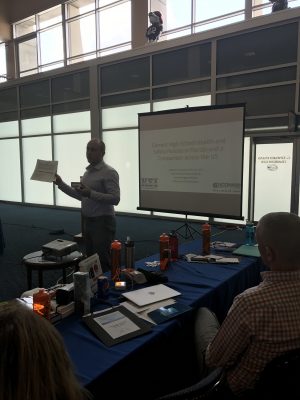When it comes to running, effective hydration requires a litany of decisions, like whether or not to use sports drinks and whether to follow your thirst versus setting a schedule. While there’s always a temptation to just do what feels right, “if you’re not hydrating well, you won’t be able to push your body as well,” says Stacy Sims, PhD, an environmental exercise physiologist and hydration expert.
Douglas Casa, PhD, has authored more than 200 publications related to heat and hydration issues for athletes. The necessity of proper hydration is something he understands from experience: “When I was 16, I suffered an exertional heat stroke during the New York state championships. I was on my final lap, and it was during the summer, and my body gave out.” In order to avoid both extreme situations like this or plain old fatigue, Sims and Casa shared their thoughts on how runners should best hydrate.
1. EVERY BODY (AND ENVIRONMENT) IS DIFFERENT
“Most people assume fluid loss is the same for everyone, but it’s different for each individual,” says Casa. “Everyone has a different sweat rate. The three things to consider are the intensity of your run, the environmental conditions and your body size.” Men and women also require different hydration strategies. “When we run, there are so many things that affect thirst sensation,” says Sims, which is why she doesn’t recommend the drink to thirst philosophy. “It changes across your menstrual cycle, for example.” Her advice? “Sip, sip, sip” water with a dash of salt as you go.
2. START YOUR RUN HYDRATED
Sims notes that starting out properly hydrated is perhaps the best thing that you can do to ensure a well-hydrated run. “That doesn’t mean slamming back water, though,” she clarifies. “It means eating a diet with plenty of watery fruits and vegetables and, unless a medical condition requires otherwise, you don’t have to be afraid of salt.”
3. FOLLOW THE 60-MINUTE RULE
While hydration is important, it’s not something you have to worry about if you’re out on a shorter run, anything around an hour or less, and started out hydrated. “Consider the sun and humidity, of course, and maybe back it up to 30 minutes or so, but for the most part you’re good as long as you rehydrate throughout the day,” says Sims.
4. DON’T OVERDO IT
“It’s important that people understand that they can drink too much,” cautions Casa. “If you drink so much that you dilute the sodium in your system, that can be dangerous too.” He also advises against launching a new hydration strategy in a race. Your stomach needs practice, too, when it comes to integrating a new hydration strategy.
5. TAKE REHYDRATION SERIOUSLY
“Rehydration can boost your immune system, get cortisol down and help your circulation — it’s important,” explains Sims. “The best way to go about it is by eating a lot of watery fruits and veggies and a protein-based drink like a yogurt smoothie. Hot soup is a great way to rehydrate after a cold run even if you don’t feel dehydrated.”
Want to implement these tips? Casa recommends backpack or water belts, which “are easy ways to carry water with you when you’re out for a run.” If you don’t want to carry water with you, Sims suggests routing your run to pass by water fountains or other water sources.
by CINNAMON JANZER
Source: MapMyRun Blog


